Under most old houses and under each new, as well as under the cottages built to the latest building, there is an underground floor - this is a basement that the hosts are usually used for storing vegetables, blanks, seasonal things.
In modern buildings (brick or wooden house), the basement can be equipped with a functional residential room, such as the office, workshop, gym, home theater, billiard room, etc.
Regardless of the destination, it is possible to use the basement only if the temperature in it is comfortable. Even if the basement height does not allow you to arrange a full-fledged room in it, it still needs insulation, since the heat insulation of the basement is one of the effective ways to reduce heat loss in the house.
Do I need to warm the basement?
From the description above it becomes obvious that yes, the basement is better to insulate. We give a few more arguments for those who doubt:- Effectively uses the useful area;
- The appearance of fungi and mold in the basement, which are the source of unpleasant odor and the deterioration of the microclimate on the lower floor of the house;
- The temperature in the insulated basement is not lowered to a minus mark;
- The insulation of the basement in the house makes it possible to protect the foundation from dampness and deformations due to the powder;
- The pace of destruction of the founding of the building is reduced;
- Decreases electricity or gas consumption for home heating.
Note. If the basement is not insulated, according to GOST 9561-91 "Reinforced concrete slabs", it is necessary to warm the overlap, which separates the floor of the first floor from the displeasted zone. The same requirement is spelled out in SNiP 2.08.01-85
To note, the technology of insulation of the cellar is similar, but has some differences.
Types of insulation basement
The insulation of the basement can be performed in several ways:
- Inner insulation . Simpler, but requires work to eliminate moisture, otherwise the appearance of condensate will reduce all insulation;
- Outdoor insulation . Allows you to exclude the drainage of the wall outside. This method of thermal insulation is more rational, because Provides better protection and does not reduce the useful space of the room, but it is more laborious. As a rule, it is performed at the construction stage of the house;
- Combined insulation . It is most effective because it includes the installation of thermal insulation material and the waterproofing of the basement on both sides.
The choice of method is determined by such factors as:
- humidity regime;
- the presence of heating in the basement;
- the presence of the drainage system around the basement;
- Appointment of basement.
Materials for insulation basement
First, the owner of the house must decide how to insulate the basement. In the construction market there are many types of thermal insulation materials with the most different characteristics.
Article on the topic: Folding bath for newborns
Consider the most popular insulation from the point of view of the expediency of use for the heat insulation of the basement:
- Styrofoam . The cheapest and affordable insulation material. For insulation, a foam with a density of 25 kg / mkb is used.
Polyfoam is popular for the properties: lightness, resistance to rotting, excellent thermal insulation characteristics, inability to absorb moisture, long service life. That is why the insulation of the basement of foam is one of the common ways to increase the thermal insulation characteristics of the basement. But one should not forget that the foam cannot be used in premises with a high risk of fire to eliminate the likelihood of fire. This material is combustible and most importantly - highlights harmful toxic substances during combustion;
- polystyrene foam . More modern analogue of foam. It has all the properties that are inherent in foam, but is characterized by a higher density (which means stronger), the presence of a "groove-crest" system.
At the same time, the polystyrene foam is characterized by simplicity of mechanical processing (the sheet does not crumble when cutting), stability resistance and higher price. The insulation of the basement was actively practiced by expanded polystyrene foam. This material is best suited to carry out the insulation of the basement outside and from the inside;
- Polyurene Foolder . Sprayed thermal insulation material. The feature of the PPU consists in the ability to fill the smallest gaps. Polyurethane foam does not let moisture, does not rot, it does not burn, provides complete tightness of the room. The insulation of the basement polyurethane foam allows you to create a solid outer layer of isolation. The shortcomings include high cost and the inability to perform work with their own hands;
- mineral wool . The insulation of the basement from the inside allows the use of soft insulation and only subject to the absence of moisture. Minvata - hygroscopic and when wetting loses its thermal insulation properties;
- Ceramzit . Despite the fact that this is a bulk insulation, it has good thermal insulation properties. Nevertheless, the insulation of the basement clamzite is justified only for the insulation of the floor in the basement and to protect the foundation outside, since the clay gravel (crushed stone) provides good drainage.
Insulation, his appearance and thickness, is selected individually for each specific case. The selection of thermal insulation material can be entrusted with a professional that calculates the required thickness with many factors. And you can make calculation yourself. To do this, you can use the recommendations that contain:
- SNIP II-3-79 "Building Heat Engineering"
- Handbook of heat and sound insulation designs. Walls of basements and foundations;
- SNiP 23-02-2003 "Thermal protection of buildings"
As well as:
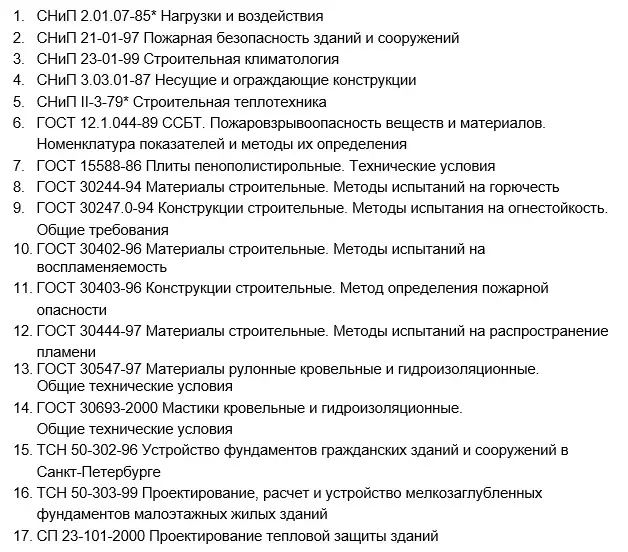
Heat engineering requirements for the insulation for the basement
The study of the above documents makes it possible to allocate the main heat engineering requirements:
- heat transfer resistance (SNiP 23-02-2003). For Moscow - RO = 4.15 m2 • ° C / W.
The dependence of the thermal conductivity coefficient of the insulation and its thickness for the inner insulation of the basement (table)

The dependence of the thermal conductivity coefficient of the insulation and its thickness for the outer insulation of the basement (table)

- perception of loads (SNiP 2.01.07-85);
- Heat resistance to the enclusive design. Calculation of the amplitude of temperature fluctuations is based on SNiP positions 23-02-2003;
- Parry permeability of the enclosing structure (SNiP 23-02-2003).
- Fire safety requirements (SNiP 21-01-97, GOST 30247, GOST 30403).
Article on the topic: What is the accumulative electric water heater?
The selected material imposes an essential imprint to the choice of technology and determines how and how to insulate the basement in a private house correctly.
Technology of insulation celled with their own hands
Consider how the complex insulation of the basement of the penplex (technology will be similar to foam and expanded polystyrene). Note that the complex thermal insulation includes an outer and internal insulation (in particular walls, gender, overlap).In addition to the insulation, you will need:
- material for interior decoration;
- mounting foam;
- Reinforced polymer grid;
- Waterproofing material (bituminous mastic);
- glue solution;
- Concrete or plaster outdoor;
- tool.
Requirements for waterproofing
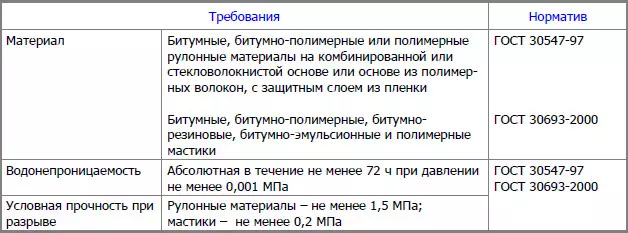
Requirements for thermal insulation

Requirements for plastering
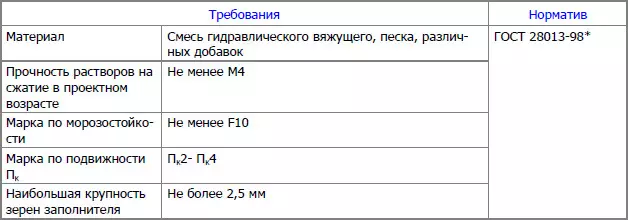
Warming basement Outside
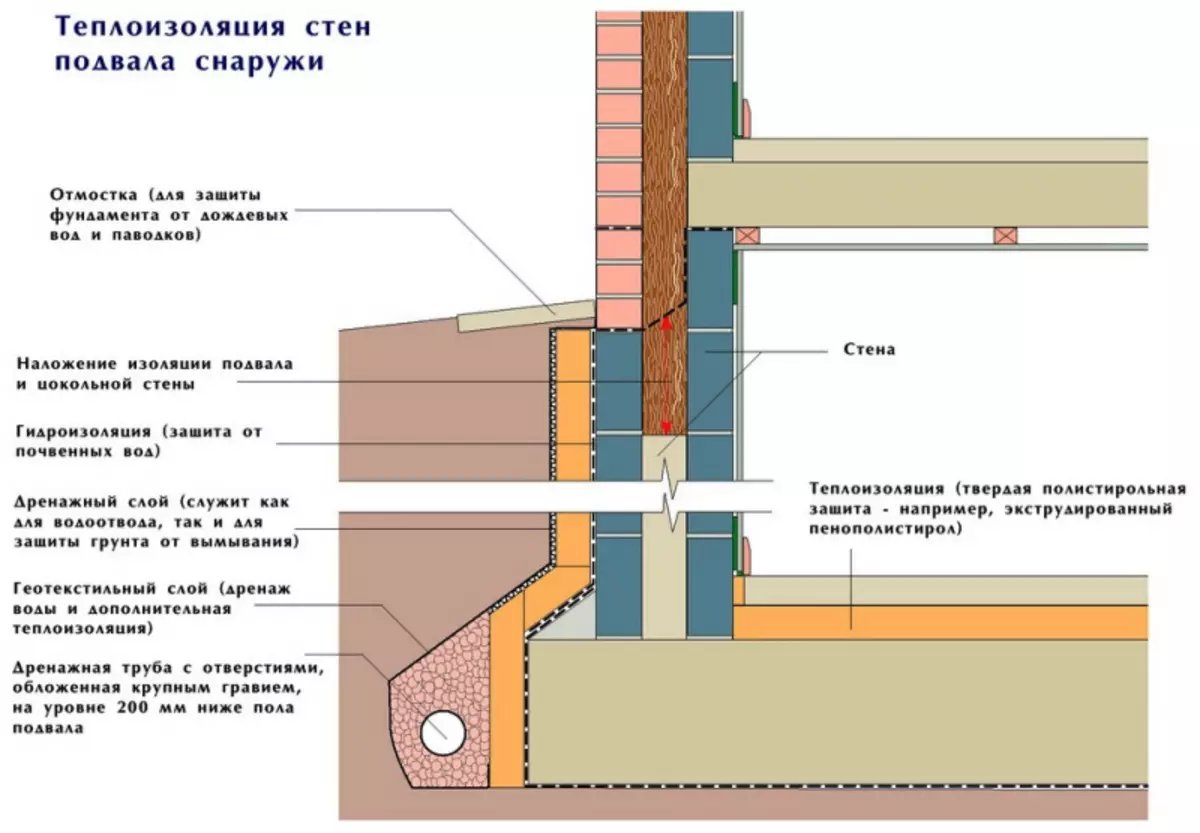
Wall insulation basement outside
Recommendations and procedure for performing work:
- Work is carried out only in dry weather and in the warm season. This ensures minimal soil moisture near the foundation;
- Works are starting to insulate from ground removal near the foundation;
- Further, the foundation is examined for cracks, detachment of waterproofing materials, significant irregularities, etc.;
- The first layer of waterproofing is applied. Masters recommended to apply moisture-repellent mastic and apply it with a solid layer;
- The insulation is stacked. For the outer insulation of the basement, it is preferable to use polystyrene foam or polyurethane foam. Because These materials are distinguished by a reliable clutch with each other and a long service life.
The insulation is mounted in such a way that it is 500 mm. He spoke on top of the foundation (above the level of the soil). An important feature: When installing the insulation, dowels-umbrellas are not used, and only adhesive solution. The solution is applied with a toothed spatula, which makes it possible to evenly apply glue to expanded polystyrene foam or polyurethane foam and avoid the appearance of emptiness under the sheet. Also, the use of glue will eliminate damage to the sheet. In the presence of cracks between the sheets, they are placed by mounting foam;
- The second layer of waterproofing is applied. This layer is important to apply to the surface of the insulation, which will be in the soil;
- The drainage system is equipped. Drainage around the house is needed so that water is not stood near the insulation;
- Decorative design of the base (for example, plaster, siding covering).
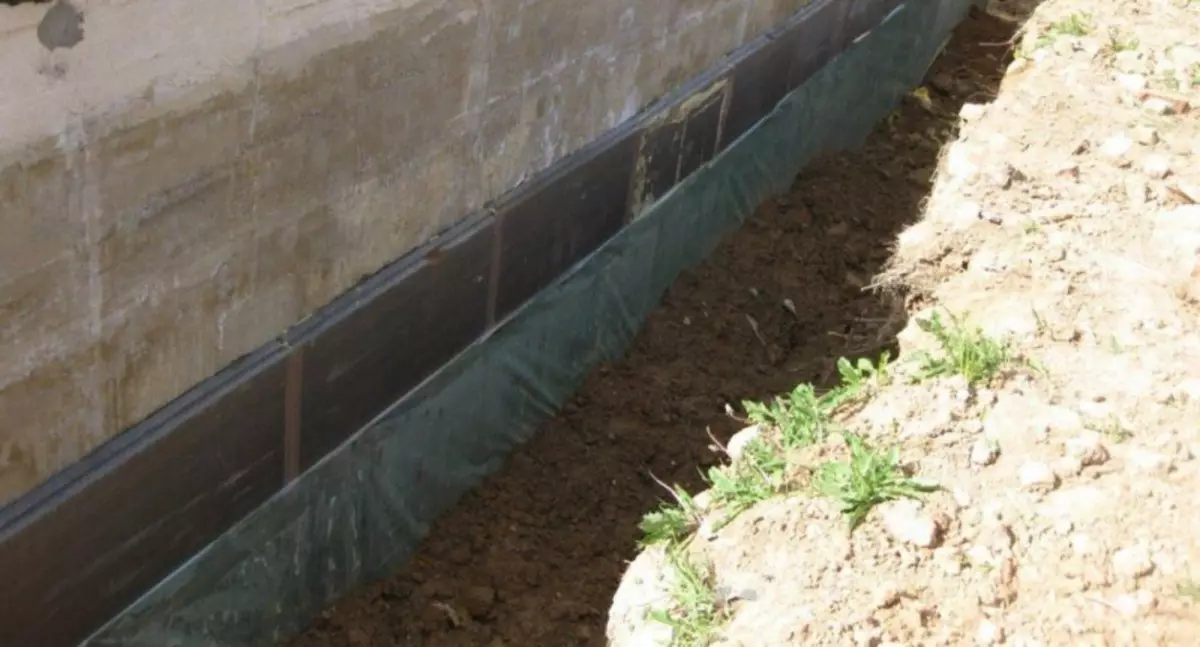
How to insulate the walls of the basement outside
Note. Installation of insulation outside the mandatory component of work on the insulation of the basement walls. Because Installation of the insulation inside the basement with high humidity will lead to the fact that the foundation will collapse from water affecting from outside.
The insulation of the basement from the inside
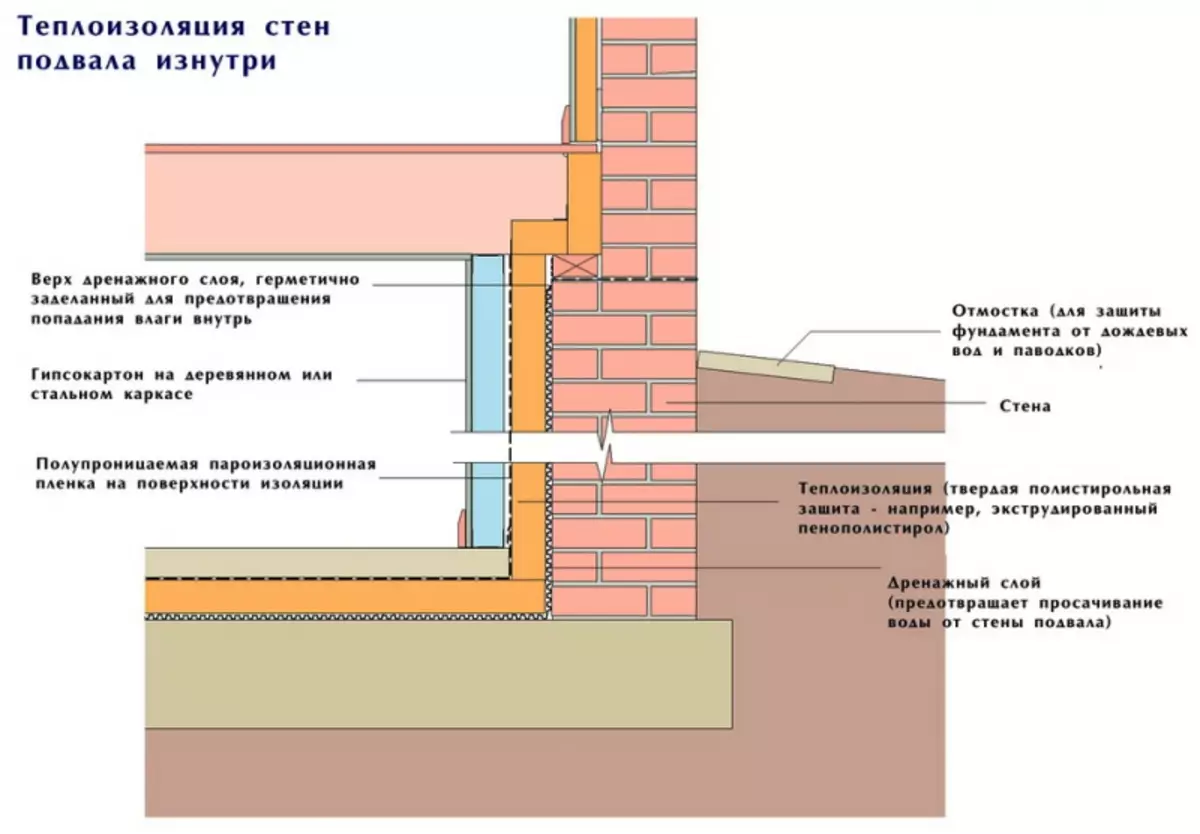
Wall insulation basement from the inside
Step-by-step instructions in the form of recommendations and rules.
Inside the room, the heat-insulating material is advisable to mount on all surfaces: walls, ceiling and floor. If the basement is assumed to be left unheated (cold), it is necessary to carry out insulation of heating pipes in the basement to avoid losses of the coolant temperature during the passage through the basement.
Before making thermal insulation, it is important to ensure full ventilation of the basement. The easiest way to arrange the air exchange is to do two holes on the opposite walls of the basement.
Article on the topic: Interior doors White oak in the interior of the apartment
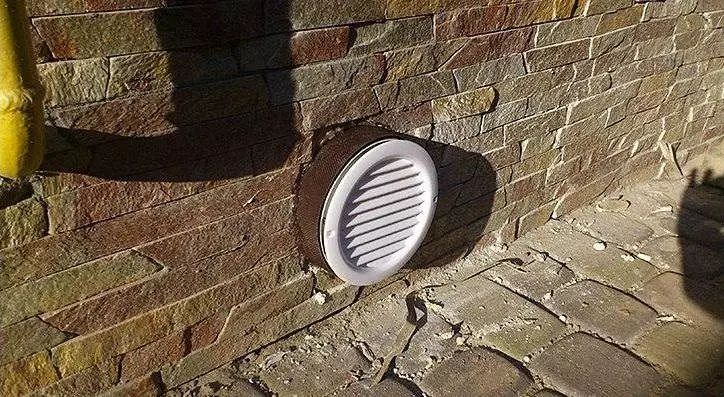
Ventilation hole in the basement wall
Wall insulation basement from the inside
The order of work is largely similar to outdoor insulation:- The polymer mesh is attached;
- Application of waterproofing. So that the primer can dry, it is necessary to ensure ventilation in the basement;
- Check the walls for the presence of deformations, irregularities (which cannot be leveled by the adhesive mixture), protruding parts;
- Mounted heat insulator;
- A plaster is applied for internal work.
When using another finishing material, appropriate preparatory work are made, for example, a framework is equipped with drywall trim.
Warming cold ceiling basement
The heat insulation of the ceiling is performed at mandatory with any method of insulation of the basement. Because The insulation of floors from the basement allows to reduce the temperature difference between the floor of the room in the house and air in it. The order of work depends on the type of overlap, which is established between the first floor and the basement.
For wooden floors:
- polystyrene foam (foam or penplex) is mounted;
- Ceiling inspection is carried out;
- A foofol is installed - a foil film that reflects heat into the room;
- Finishing works are performed.
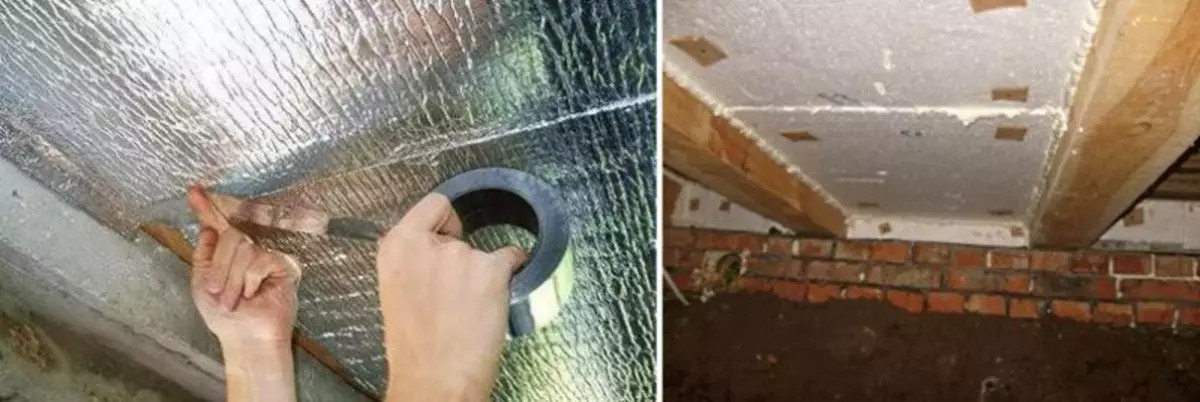
How to insulate the basement ceiling
For reinforced concrete floors requires the arrangement of a false ceiling, whose task to reduce heat loss through concrete. Falsepotor is a suspended ceiling design with a thermal insulation layer of a considerable thickness (suggests decorative trim).
Floor insulation basement
The main task of thermal insulation of the floor so that the heat does not leave the basement to the ground. Even if we are talking about the unheated basement. Choosing how to insulate the floor in the basement, should be closed to two options:Option 1. Floor insulation with clay or "Paul by soil"
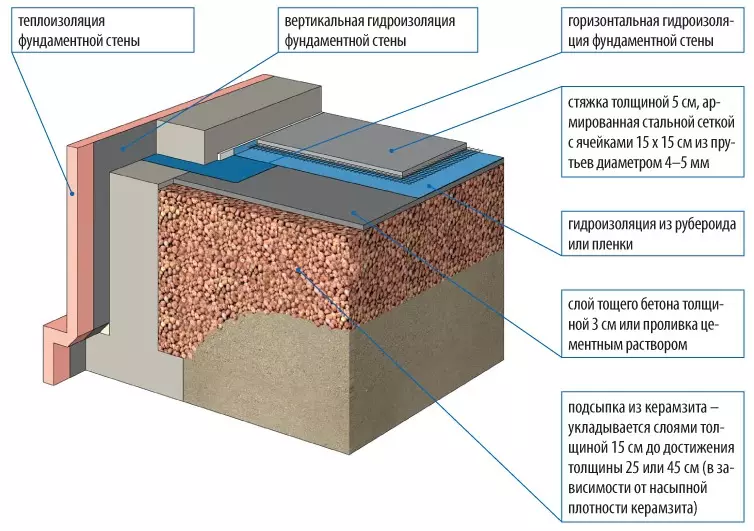
Floor insulation scheme in the basement on the ground
Ceramzite falls asleep on the floor, it is fluttering, and a metal mesh is stacked on top of it and a layer of skinny concrete is poured. To avoid the shift of the clamzite when driving, make a frame from the processed timber, in the cells of which are covered with clay gravel or metallic beacons (if a thin layer) is installed. Filed ceramzite is leveled by the rule. After that, the floorproofing of the floor and the floor screed is performed.
Option 2. Floor insulation polystyrene foam
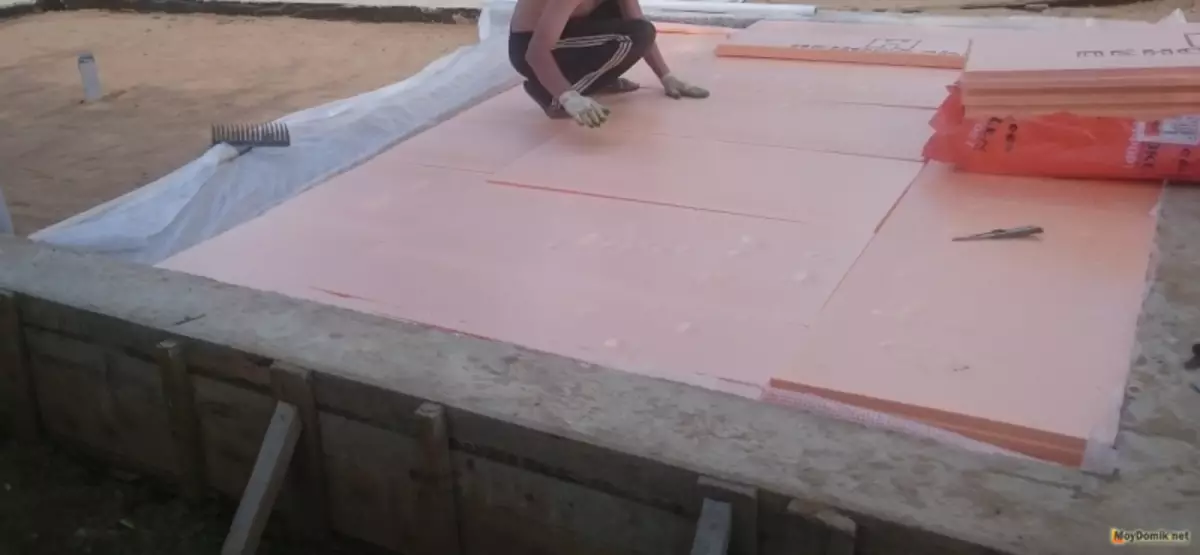
Floor insulation basement penplex (at home construction)
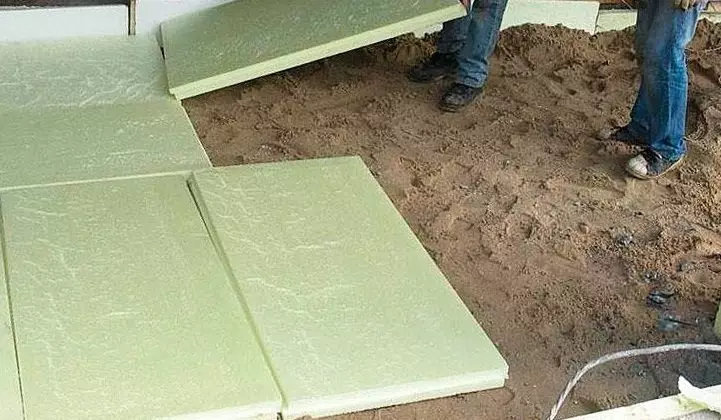
Floor insulation basement expanded polystyrene
In this case: the floor in the basement is equalized, stiff foam stoves are placed on it, waterproofing (for example, runneroid) is stacked on the slabs in such a way that the edges of the cloth 150 mm enter the wall. After that, a concrete screed with a thickness of 30-50 mm is poured, which is recommended to reinforce to eliminate the deformation of the heat insulating cake.
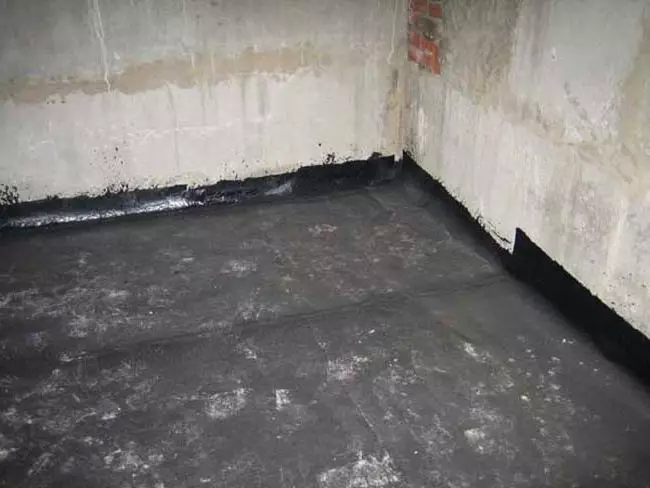
Waterproofing floor in the basement of a private house
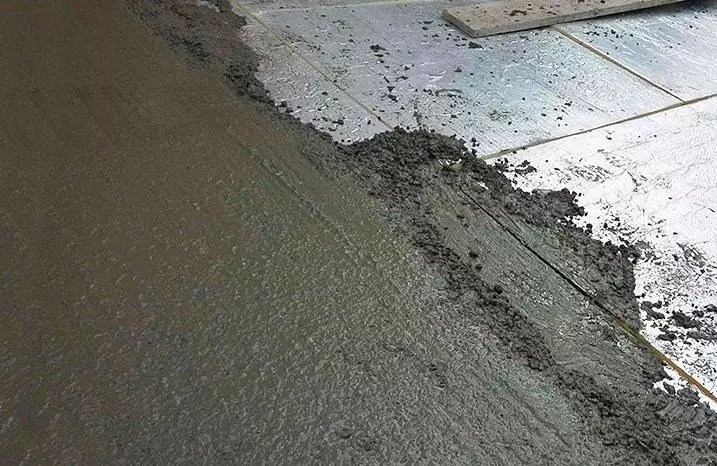
Pouring screed on the floor in the basement
Warming of doors in the basement
The last stage, which will prevent the receipt of cold air from the unheated basement through the door to the room on the first floor of the house.Conclusion
Thus, the comprehensive insulation of the basement in a private house will expand the scope of use of the basement, it will reduce heat loss and reduce heating costs.
